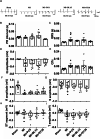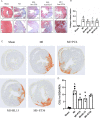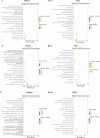Comparative Study of Different Acupoints for Treating Acute Myocardial Ischemia in Mice
- PMID: 36689154
- PMCID: PMC10300188
- DOI: 10.1007/s12265-022-10346-6
Comparative Study of Different Acupoints for Treating Acute Myocardial Ischemia in Mice
Abstract
Acupuncture point specificity has been recognized as a key scientific issue in traditional Chinese medicine (TCM), but there is limited clinical trial or animal study to verify the characteristics of PC6, BL15, and ST36 in the protection from myocardial injury. We aimed to compare the effects among these three acupoints on the acute myocardial infarction mice model and to explore possible mechanisms for the first time. We found that PC6 is the most appropriate acupoint to deliver efficacy and safety to treat acute MI in mice. BL15 stimulation improved the systolic function, but increased the risk of arrhythmia. ST36 only slightly attenuated systolic function and had no effect on arrhythmia during MI. RNA profiles of skin tissue in local acupoints demonstrated that the most altered DEGs and related pathways may partly support its best effects of PC6 treatment on MI injury, and support the observed phenomenon of the acupoint specificity.
Keywords: Acupoint specificity; Acupuncture; Fibrosis; Inflammation; Myocardial infarction.
© 2023. The Author(s).
Conflict of interest statement
The authors declare no competing interests.
Figures












Similar articles
-
The Beneficial Effects of Electroacupuncture at PC6 Acupoints (Neiguan) on Myocardial Ischemia in ASIC3 -/- mice.J Acupunct Meridian Stud. 2018 Jun;11(3):88-96. doi: 10.1016/j.jams.2018.03.002. Epub 2018 Mar 31. J Acupunct Meridian Stud. 2018. PMID: 29608997
-
Comparison of Beneficial Effects of Acupuncture at PC6, LU7 & Non- acupuncture Points on Cardiac Cell Function in Myocardial Ischemia (MI) Rats by Testing Protein Expression of L-type Calcium Channel Protein and its Related Protein.Acupunct Electrother Res. 2016;41(2):107-125. doi: 10.3727/036012916x14666839504631. Acupunct Electrother Res. 2016. PMID: 29897687
-
The beneficial effect of electro-acupuncture given at PC6 (Neiguan-point) by the increase in cardiac transient outward K+ current channel which depends on the gene and protein expressions in artificially induced myocardial ischemia rats.Acupunct Electrother Res. 2014;39(3-4):259-73. doi: 10.3727/036012914x14109544776132. Acupunct Electrother Res. 2014. PMID: 25693308
-
[Regularities of acupoint combinations and characteristics of core acupoint application for acupuncture-moxibustion treatment of mammary gland hyperplasia based on complex network analysis].Zhen Ci Yan Jiu. 2021 Jan 25;46(1):76-83. doi: 10.13702/j.1000-0607.200696. Zhen Ci Yan Jiu. 2021. PMID: 33559431 Review. Chinese.
-
Analysis of acupoint selection and prescription rules of acupuncture for treatment of stable angina pectoris based on a Traditional Chinese Medicine inheritance calculation platform: A systematic review.Medicine (Baltimore). 2022 Dec 9;101(49):e31466. doi: 10.1097/MD.0000000000031466. Medicine (Baltimore). 2022. PMID: 36626434 Free PMC article.
Cited by
-
Neuro- and immuno-modulation mediated by the cardiac sympathetic nerve: a novel insight into the anti-ischemic efficacy of acupuncture.J Tradit Chin Med. 2024 Oct;44(5):1058-1066. doi: 10.19852/j.cnki.jtcm.20240423.001. J Tradit Chin Med. 2024. PMID: 39380238 Free PMC article. Review.
-
Efficacy and mechanism of transcutaneous electrical acupoint stimulation for angina severity in patients with chronic coronary syndromes: study protocol for a multicentre randomised controlled trial.BMJ Open. 2024 Oct 21;14(10):e084218. doi: 10.1136/bmjopen-2024-084218. BMJ Open. 2024. PMID: 39433410 Free PMC article.
References
Publication types
MeSH terms
LinkOut - more resources
Full Text Sources
Medical

